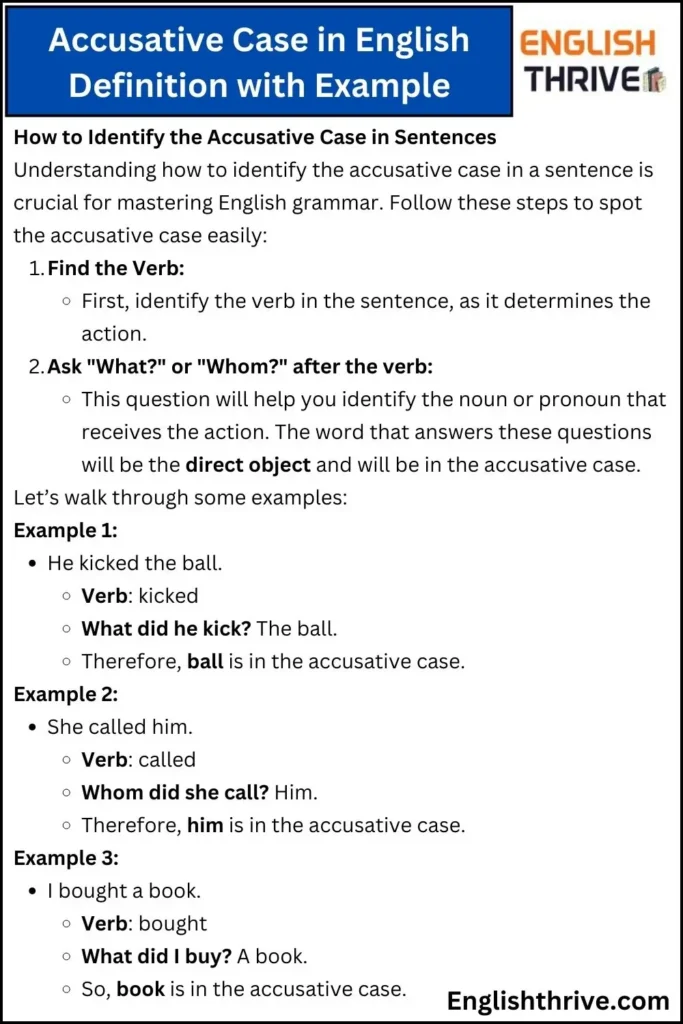In the English language, certain grammatical rules help us understand the structure and meaning of sentences. One such rule involves cases, which refer to the form of a noun or pronoun based on its role in a sentence. Among these cases, the accusative case in English plays a crucial role in identifying the direct object of a verb. This article will help clarify the concept of the accusative case in English, show how it functions, and explore some common examples.
Contents
ToggleWhat Is the Accusative case in English?
The accusative case is a grammatical case that primarily indicates the direct object of a verb. This case is used to show what or who receives the action performed by the subject. While the term accusative case is commonly encountered in languages like Latin, German, or Russian, in English, it is often referred to as the objective case, which includes both the accusative and dative cases.
Direct Object Defined
To better understand the accusative case, it’s essential to know what a direct object is. A direct object is the noun or pronoun that receives the action of the verb. You can typically identify the direct object by asking the question “What?” or “Whom?” after the verb.
For example:
In the sentence “She read the book,” the verb is read, and when we ask, “What did she read?” the answer is the book, making it the direct object in the accusative case.
Examples of the Accusative Case
Let’s explore a few examples to see the accusative case in action. These will help you understand how the direct object is always placed in the accusative case in English.
1. Using Nouns in the Accusative Case:
She ate the apple.
Here, apple is the direct object of the verb ate and is in the accusative case.
They built a house.
House is the direct object and is in the accusative case.
I saw the movie last night.
Movie is the direct object, thus in the accusative case.
2. Using Pronouns in the Accusative Case:
Pronouns change form when they function in the accusative case. Here are some common examples:
I saw him at the park.
Him is the pronoun in the accusative case.
She gave me a gift.
Me is in the accusative case.
They invited us to the party.
Us is the accusative form of the pronoun.
As you can see, the accusative case in English affects only pronouns, not nouns. While nouns remain unchanged, pronouns like I, he, she, we, they change to me, him, her, us, them in the accusative case.
How to Identify the Accusative Case in Sentences
Understanding how to identify the accusative case in a sentence is crucial for mastering English grammar. Follow these steps to spot the accusative case easily:
Find the Verb:
First, identify the verb in the sentence, as it determines the action.
Ask “What?” or “Whom?” after the verb:
This question will help you identify the noun or pronoun that receives the action. The word that answers these questions will be the direct object and will be in the accusative case.
Let’s walk through some examples:
Example 1:
He kicked the ball.
Verb: kicked
What did he kick? The ball.
Therefore, ball is in the accusative case.
Example 2:
She called him.
Verb: called
Whom did she call? Him.
Therefore, him is in the accusative case.
Example 3:
I bought a book.
Verb: bought
What did I buy? A book.
So, book is in the accusative case.
By following these steps, you can easily identify when a noun or pronoun is in the accusative case.

Accusative Case vs. Other Cases in English
In English, there are a few other important cases, such as the nominative case and the genitive case. Understanding the distinction between these cases is essential for recognizing how different noun and pronoun forms function in sentences.
1. Nominative Case
The nominative case refers to the subject of a sentence, the noun or pronoun that performs the action of the verb. For example:
He kicked the ball.
Here, he is the subject and is in the nominative case.
2. Genitive Case
The genitive case is often used to show possession. While English generally uses apostrophe-s to show possession (e.g., John’s book), some languages (e.g., Latin, German) use a distinct genitive case form.
3. Objective Case (Accusative + Dative)
As mentioned earlier, the accusative case is often referred to as part of the objective case in English, which also includes the dative case. The dative case deals with the indirect object of a sentence, showing to whom or for whom the action is done. In contrast, the accusative case focuses on the direct recipient of the action.
Example:
She gave me the book.
Book is in the accusative case (direct object).
Me is in the dative case (indirect object).
Common Mistakes with the Accusative case in English
While the accusative case might seem simple, there are several common mistakes that learners of English often make. These errors usually occur due to confusion between different cases, misuse of pronouns, or misunderstandings of sentence structure. Below are some common pitfalls and how to avoid them:
1. Confusing the Accusative and Nominative Cases
A frequent mistake occurs when a pronoun in the nominative case is mistakenly used in the accusative case position. This happens because English pronouns change form depending on their function in a sentence.
Example of mistake:
I saw she at the party.
In this sentence, “she” should be in the accusative case as it is the direct object.
Correct version:
I saw her at the party.
Here, her is the correct accusative form.
To avoid this, always remember that I, he, she, we, they are nominative case pronouns, while me, him, her, us, them are accusative case pronouns.
2. Omitting the Direct Object
In some cases, learners may forget to include the direct object, which is necessary for identifying the accusative case. A direct object is crucial for the verb to complete its action, and without it, the sentence might become incomplete or confusing.
Example of mistake:
She kicked.
The sentence is incomplete because we don’t know what she kicked.
Correct version:
She kicked the ball.
Now, we have the direct object (“the ball”), which is in the accusative case.
3. Using the Incorrect Pronoun Form
Sometimes, learners mistakenly use a subject form of a pronoun when the accusative form is needed. The confusion often arises between subject and object pronouns.
Example of mistake:
They saw I at the store.
“I” is a subject pronoun, but the sentence requires an object pronoun.
Correct version:
They saw me at the store.
Me is in the accusative case, making the sentence grammatically correct.
4. Overcomplicating Sentence Structure
While the accusative case is relatively simple, some learners make sentences overly complicated by attempting to include too many details or by not maintaining clear subject-object relationships. This can lead to awkward or convoluted phrasing.
Example of mistake:
He gave it to the teacher the book.
The sentence order is confusing, making it difficult to identify the direct object.
Correct version:
He gave the book to the teacher.
The sentence now clearly shows the direct object (“the book”) in the accusative case.
By keeping sentence structures simple and clear, you’ll avoid these common mistakes.
Prepositions and the Accusative case in English
In many languages, prepositions are closely tied to specific cases. For instance, in languages like German, prepositions such as durch, für, and gegen require the accusative case. However, in English, prepositions are generally followed by the objective case, which includes both the accusative and dative cases.
Common Prepositions and the Accusative Case
Some prepositions in English may appear to take the accusative case, but it is more accurate to say that they require the objective case. When you use prepositions like with, for, at, or about, the pronouns following them should be in the objective case.
Examples:
She walked with him.
“Him” is the pronoun in the accusative case (objective case) following the preposition “with.”
I will go for it.
“It” is in the accusative case, following the preposition “for.”
Prepositional Phrases
Prepositions often form phrases that help provide additional detail or context in a sentence. These phrases can sometimes include an accusative object, such as in:
The book is on the table.
Here, “the table” is in the accusative case as the object of the preposition “on.”
It’s important to note that not all prepositions will take an object in the accusative case, but many will follow the objective case rule, especially with pronouns.
More Examples of the Accusative Case in English
Understanding the accusative case through examples is one of the best ways to learn. Below are several sentences that illustrate the use of the accusative case with both nouns and pronouns.
Examples with Nouns in the Accusative Case:
I watched the movie last night.
Movie is the direct object of the verb “watched” and is in the accusative case.
He built a house for his family.
House is in the accusative case as the direct object of the verb “built.”
Examples with Pronouns in the Accusative Case:
She called me last night.
Me is the accusative form of “I” and is the direct object of the verb “called.”
He took it from the shelf.
It is in the accusative case, acting as the direct object of “took.”
How the Accusative Case Impacts Sentence Structure
The accusative case plays a significant role in English sentence structure, especially when it comes to making the meaning of the sentence clear. By understanding how the accusative case works, you can write more effectively and avoid confusion in your sentences. Here’s how the accusative case impacts the flow of a sentence.
1. The Importance of Word Order in English
In English, word order is essential for understanding who is doing the action and who is receiving it. The typical subject-verb-object structure places the subject at the beginning, followed by the verb, and the direct object (which is in the accusative case) at the end of the sentence.
For example:
She kicked the ball.
She (subject) is performing the action of kicked (verb) on the ball (accusative object).
If the order is disrupted, it could lead to a grammatically incorrect sentence or one that is difficult to understand.
Example of incorrect order:
Kicked the ball she.
This sentence is confusing because the subject is not in the right place.
Corrected version:
She kicked the ball.
The sentence now follows the standard structure and is clear.
By maintaining this word order, you ensure that the accusative case is used correctly and that your sentence remains easy to understand.
2. Accusative Case and Sentence Clarity
When the direct object is correctly placed in the accusative case, it improves sentence clarity. This is especially important when using pronouns because changing their form can indicate a shift in sentence meaning. The use of the accusative case helps to clarify the relationship between the subject, verb, and object.
For example:
I saw him yesterday.
Here, him clearly refers to the person being seen, making the sentence easy to interpret.
However, if we were to use the wrong form:
I saw he yesterday.
This sentence is incorrect because he is a nominative form and doesn’t work as the direct object in this sentence.
By ensuring that the correct accusative form is used, you prevent confusion and maintain sentence clarity.
Advanced Tips for Using the Accusative Case in English
While understanding the basics of the accusative case is essential, there are a few advanced tips that can help you refine your understanding and usage of this grammatical structure. These tips will help ensure that you not only use the accusative case correctly but also express your ideas more efficiently.
1. Pronouns in Compound Sentences
In compound sentences, the accusative case can sometimes be used in conjunction with other cases, especially when there are multiple objects or subjects. It’s crucial to maintain consistency in pronoun forms throughout the sentence to avoid grammatical errors.
Example:
He gave it to me, and I thanked him.
In this sentence, it and me are in the accusative case, and him is also in the accusative case. The sentence maintains grammatical consistency, making it clear who is doing what.
If you switch the pronouns incorrectly, the sentence could become unclear or grammatically wrong:
He gave it to I, and I thanked he.
This would be incorrect, as I and he should be in the nominative case when they are subjects.
2. Using the Accusative Case with Two Objects
In some cases, sentences contain both a direct object (in the accusative case) and an indirect object. English typically places the direct object after the verb, while the indirect object can be placed either after the direct object or before it (depending on the sentence structure).
Example:
She gave him the book.
Here, book is the direct object (accusative case), and him is the indirect object.
Alternatively:
She gave the book to him.
In this case, book is the accusative direct object, and him is the indirect object, placed after the preposition to.
It’s important to recognize the structure of sentences with both objects to maintain clarity.
3. Accusative Case with Reflexive Verbs
Some verbs are reflexive, meaning that the subject and the object refer to the same person. Reflexive verbs require a reflexive pronoun in the accusative case to show this relationship.
Example:
She hurt herself.
Here, herself is a reflexive pronoun in the accusative case, as the action is being performed on the subject (she) herself.
Understanding how reflexive verbs work ensures that you use the accusative case correctly in more complex sentence structures.
FAQs on Accusative Case in English
1. What is the accusative case in English?
The accusative case in English is used to indicate the direct object of a verb. It answers the question “What?” or “Whom?” after the verb. In English, the accusative case is mainly observed in pronouns, which change form when they function as direct objects.
Example:
She saw him at the store.
Him is in the accusative case because it is the direct object of the verb saw.
2. What are the 4 cases in English?
In English, the four main cases are:
Nominative Case – Used for the subject of a sentence (e.g., I, he, she).
Accusative Case – Used for the direct object of a verb (e.g., me, him, her).
Genitive Case – Indicates possession (commonly shown by the apostrophe-s, e.g., John’s book).
Dative Case – Used for the indirect object in a sentence, though often combined with the accusative case in modern English (e.g., to him, for us).
3. How do you know if it is accusative case?
You can determine if a noun or pronoun is in the accusative case by identifying the direct object in a sentence. After finding the verb, ask the question “What?” or “Whom?” to determine the direct object.
Example:
They ate the cake.
Cake is in the accusative case because it answers “What did they eat?”
4. Can the accusative case be used with prepositions?
Yes, in English, prepositions are often followed by pronouns in the accusative case. For example, in the phrase “with her”, her is in the accusative case.
Example:
He went with them to the concert.
Them is in the accusative case, as it is the object of the preposition with.
5. What is the difference between nominative and accusative case in English ?
The nominative case is used for the subject of a sentence (the one performing the action), whereas the accusative case is used for the direct object (the one receiving the action).
Example:
I (nominative) gave him (accusative) the gift.
I is the subject performing the action, and him is the direct object receiving the action.

